Rennie Scaysbrook | February 2, 2016
The fifth generation of the 2016 Kawasaki ZX-10R has arrived loaded with hardware and software to rival anything currently on dealer floors. How good is it? We went to Malaysia’s Sepang MotoGP circuit to find out.
The 2016 Kawasaki ZX-10R Project Leader, the famed Yoshimoto Matsuda, put it very succinctly when he spoke of his new baby to the U.S. motorcycle press in the Sepang garages.
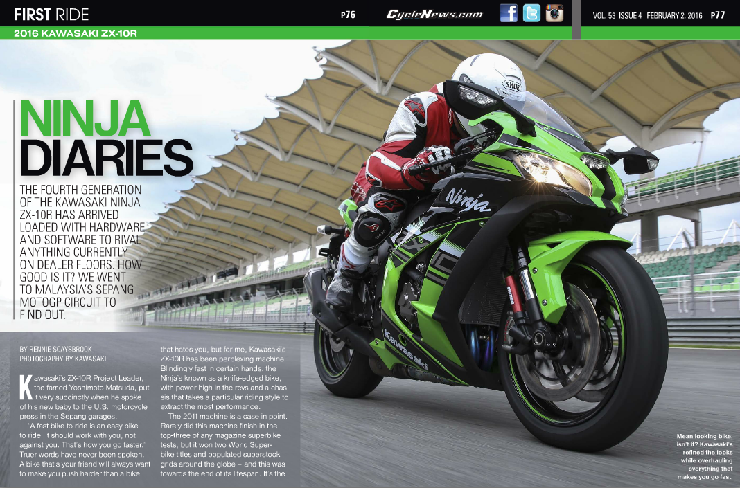
You can read the original magazine story by clicking HERE.
“A fast bike to ride is an easy bike to ride. It should work with you, not against you. That’s how you go faster.” Truer words have never been spoken. A bike that’s your friend will always want to make you push harder than a bike that hates you, but for me, the 2016 Kawasaki ZX-10R has been a perplexing machine. Blindingly fast in certain hands, the Ninja’s known as a knife-edged bike, with power high in the revs and a chassis that takes a particular riding style to extract the most performance.
The 2011 machine is a case in point. Rarely did this machine finish in the top-three of any magazine superbike tests, but it won two World Superbike titles and populated Superstock grids around the globe – and this was toward the end of its lifespan. It’s the current world champ, and you can bet your left nut keeping that WSBK title in the cabinet is absolutely top of Kawasaki Heavy Industries’ priority. So the 2016 bike must be smaller, better, smoother, faster, faster, faster.
 Mean-looking bike, isn’t it? Kawasaki’s refined the looks while overhauling everything that makes you go fast.
Mean-looking bike, isn’t it? Kawasaki’s refined the looks while overhauling everything that makes you go fast.
That’s what this bike – the fifth version of the mighty ZX-10R – aims to be. The 2016 Kawasaki ZX-10R is all-new – a totally revamped engine is physically shorter and lighter and faster revving; there’s a smaller, stiffer chassis; forks that would make Öhlins blush and an electronics suite that rivals anything on offer from Yamaha, Ducati, BMW or Aprilia. The tech game has moved on substantially since 2011, and Kawasaki’s joined the party.
Commanding the ZX-10R electronics now falls to the Bosch Inertial Measurement Unit, a component that takes information from five axes (longitudinal acceleration, transverse acceleration, vertical acceleration, roll rate and pitch rate) to determine everything from what position the bike is relative to: lean angle, slip, brake pressure, acceleration, and more. But Kawasaki has a sixth unit of measurement up its sleeve: yaw, which measures rotation around a vertical axis – take a pencil and circle your finger around its middle like an orbiting planet for a demonstration. This sixth sense is calculated by Kawasaki’s own proprietary software, and helps the traction control predict available grip and thus the amount of throttle you’re allowed to have when you slam open the gas. Fancy stuff.
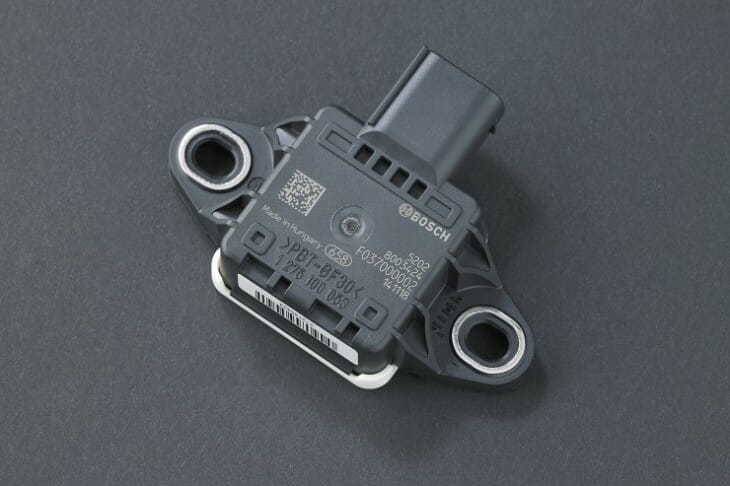 This is the little black piece of plastic that’s causing all the rage – the Bosch Inertial Measurement Unit.
This is the little black piece of plastic that’s causing all the rage – the Bosch Inertial Measurement Unit.
 The KRT edition at $16,299 is the pick of the bunch in terms of colors but…
The KRT edition at $16,299 is the pick of the bunch in terms of colors but…
 …if you want something a bit more understated (and a touch cheaper), go for the Metallic Matte Carbon Grey at $15,999.
…if you want something a bit more understated (and a touch cheaper), go for the Metallic Matte Carbon Grey at $15,999.
It all adds up to a motorcycle that’s a genuine generation apart from the 2011 model. That’s confirmed the moment you sit on the new green meanie – the pegs are higher and further back, the bars closer to your chest and the front wheel now weighted with more rider and an engine higher up and further forward in the chassis than before. The chassis is compact and tight, and this is before you’ve even gone out on track. The fairing, seat, tank, exhaust, mirrors… they’re all changed, reshaped or reduced. About the only thing familiar is that horrible dash and those budget-looking switches. Matsuda-san decided to keep this dash rather than go for a fancy new item like the Yamaha YZF-R1 so as to devote more money toward the end game of making the 10R faster.
 This is where the new 10R shines – rolling off the gas and throwing it into the corner.
This is where the new 10R shines – rolling off the gas and throwing it into the corner.
It’s easy to see why Kawasaki chose Malaysia’s Sepang to showcase the new 10R – it’s a very front-end-reliant track to highlight steering prowess, with tire-shredding corner exits that show off a good TC system. If the bike doesn’t steer, you’re in deep crap here, so it’s lucky this new 2016 Kawasaki Ninja ZX-10R turns as good as it does.
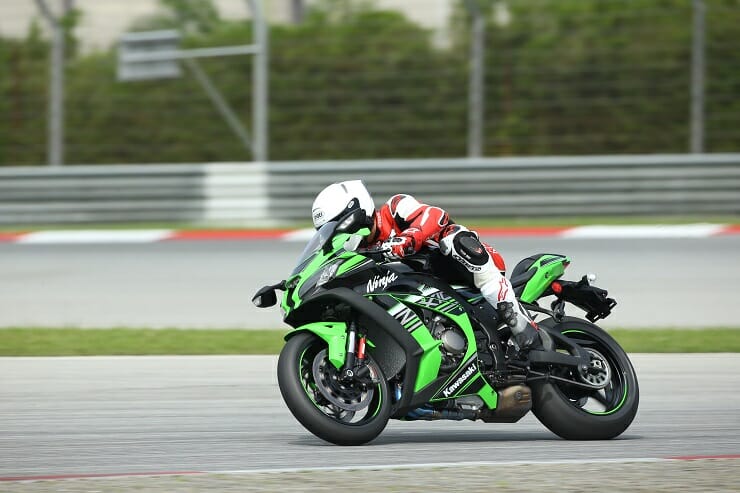 Sepang can be a lonely old place, if you don’t have a ZX-10R to play with…
Sepang can be a lonely old place, if you don’t have a ZX-10R to play with…
I won’t go as far as saying this is the best front end on any current superbike, but it’s night and day better than the old bike. Suddenly the 10R turns with the same fervor as it accelerates, with a tangible feel to match from the front tire that was previously lacking. This is down to a number of factors. The first and most obvious is the prowess of the new Showa Balance Free fork, but it’s also the revised geometry of the chassis and a crankshaft that produces less inertia to turn into a corner.
Lighter, more direct steering is the result, so much so that I found myself double-dipping a few corners due to the sheer turn speed of the chassis, which is a good problem to have.
Kawasaki has struck a chord here in that it’s removed much of the stubborn immobility of the old bike without inducing the confidence-sapping nervousness of a chassis too much the other way. The first session we rode with ABS on and Bridgestone R10 tires, but it meant next to nothing as I really didn’t know where I was going. Switching to Bridgestone slicks and no ABS for the second session onward let me really start to extend my perception of just how hard and how late I could push the 10R into the corner. On fresh slick rubber, the 10R’s chassis was sublime, turning on a dime, and going exactly where I wanted it to go. Memories of the old recalcitrant 2011 bike faded fast. The speed of direction changes were near spot-on with the 2016 edition, especially considering we were running almost standard suspension settings with slick tires. Flipping the 10R from side-to-side was so easy, and there’s now added stability on corner exits that allows you to point the machine to almost any point on the exit with the confidence that it will take you there.
This is indeed a small motorcycle – as evidenced by my massive frame perched on top in the photos. It’s actually the first bike in a while I’ve ridden that gave me a few leg cramps, meaning two things for me: I’m too fat and the pegs are in the wrong place for my riding position. I’d like them a touch lower and back, but it’s nothing a set of rearsets can’t fix.
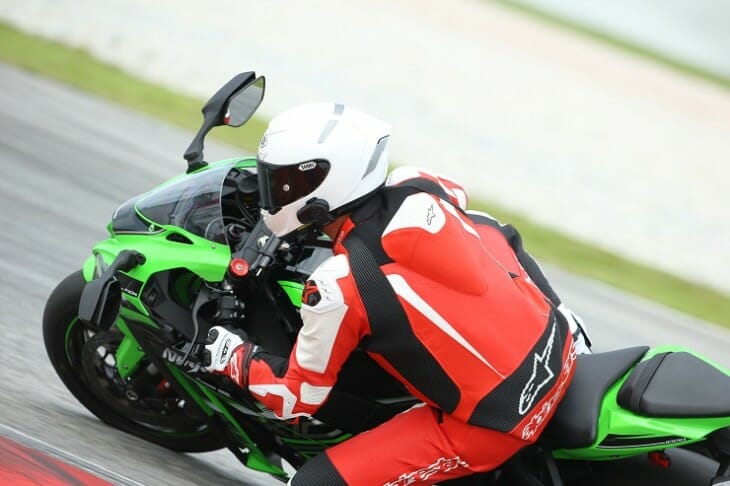 If you’re over 6 feet tall, it’ll be a tight fit on the new 10R.
If you’re over 6 feet tall, it’ll be a tight fit on the new 10R.
The Brembo M50 brake package is the same as the Ducati Panigale yet not as ferocious in its initial braking bite, and I can’t say I was overly enthused about the stopping power of the new 10R. Hammering the brakes at the end of the top-speed back straight didn’t give the overall speed reduction I was hoping for – odd, considering the similar system on the Panigale feels much more powerful.
One area that feels similar to the old 10R is the engine’s preference for sky-high revving. This is not an engine that you can happily leave a gear higher and expect it to pull you around the track like a BMW. In this case the 2016 version is a true Ninja, and it retains that wanton lust for big revs that’s been a trademark ever since the iconic 2004 master-blaster.
The lack of lowdown torque was evident in turns four (uphill right), 14 (back straight/Rossi and Marquez’s war zone) and 15 (front straight). In each of those corners I’d expect to be able to carry second gear on a 1000cc Superbike, but the 10R would fall flat unless the revs were past 9000 in second, so first gear it was.
The final gearing didn’t help, either (I suspect it was standard road gearing), as fifth gear was the last one seen on the dash before hitting the stoppers for the fast approaching turn 15 or the proceeding turn one. Sixth gear should have been attainable on straights as long as Sepang’s.
Regardless of the gearing, with the revs up the 2016 Kawasaki ZX-10R is a rocket – same as always. But this engine spins up faster than before, and once it’s past 9500 rpm you better hold on, because the red zone will flash up on the dash extremely quickly as you click up the now quickshifter-equipped gearbox through second, third and fourth gears that are now closer together than before.
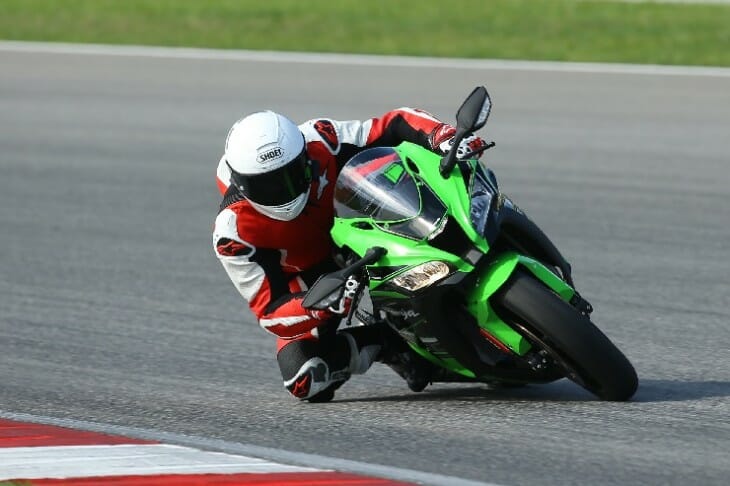 Sepang’s fast turn three really lets the chassis show off its newfound stability.
Sepang’s fast turn three really lets the chassis show off its newfound stability.
But on the side of the tire in slow-speed corners, the 10R suffers from a slightly abrupt throttle response from closed, the same as the Yamaha YZF-R1 does. And like the Yamaha, it does get better the higher the revs. This is largely down to EFI emissions control of the now Euro 4 engine, but you can get around this by fitting the race ECU that comes with a different fuel map. Or so I’m told. As I was all set to ride the race-kitted bike, Malaysia decided to drop its lunch and downpour the entire facility – so no race kit for Rennie.
The throttle is linked directly to the now five-stage traction-control system, which, in reality, is what all the fancy IMU gizmos are trying to make the most out of. I really was not a fan of the 2011 TC system – thankfully this new system is miles better than that one. After three sessions I devised my best traction-control number was 2, which gave about the same level of slip as 1 did on the 2011 bike but without the harshness on the cut-out. Level 1 lets you really hang the 10R out, however, this map is only for the very advanced riders out there, and it caught me out a couple of times when I got too greedy with the throttle. It saved me, but brutally. “Thank God for electronics,” I kept saying in my lid.
Kawasaki’s made a ZX-10R that is, without question, miles better than the previous model. Far and away the number-one feature for my book is the way the new Showa suspension combines with the revamped chassis to create a bike that turns the way it always should have. That already makes this bike a massive improvement, and that’s without taking the electronics or engine changes into consideration. Plus, the incredibly advanced electronics now mean the 10R is equal to anything on offer from Japan or Europe, whereas it was not before.
The engine’s lack of low-down torque is a bit of a letdown, but that trademark Ninja appetite for revs is still there. That’s what makes a Kawasaki superbike – big revs, a banshee wail from the exhaust and now, a chassis that works with you rather than against. It’s still a bike that will require a certain riding style to get the most out of, but it’s now a bike that’ll work for a much broader range of riders – from World Superbike to the Sunday scratcher – than the old bike could ever hope to.
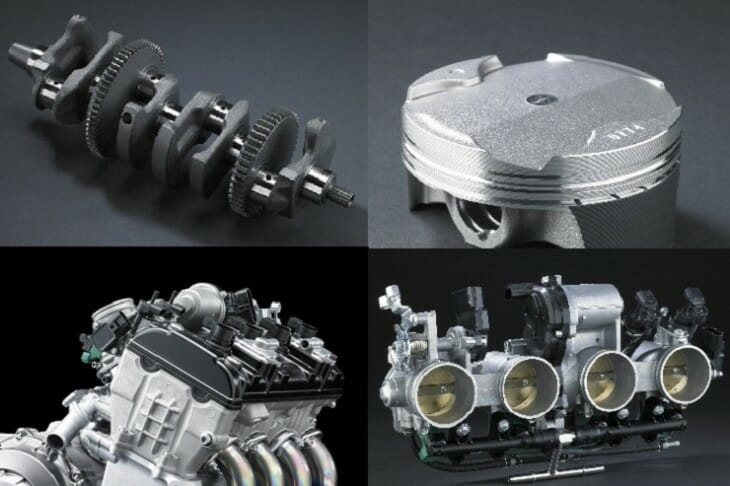 Clockwise from top left:
Clockwise from top left:
Down The Bottom: The crankshaft has gone on a diet and has shed one pound of overall weight. Less weight gives two benefits – faster spin-up off the bottom of the rev range and less inertia to move from side to side on turn-in. Engine balancer has also been slightly lightened.
In The Middle: The over-square 76 x 55mm bore and stroke dimensions have been carried over from the previous model. Pistons are now 1.5mm shorter at 37.7mm and 5g lighter than the 2011 model, with a revised crown designed to handle the greater power of the 2016 engine. Pistons are now coated with a new dry film lubricant coating, designed to reduce friction at low rpm and help with new engine break-in.
Up The Top: The cylinder head’s overall height has been shortened, housing a more compact valve train with the same longer reach spark plugs as the supercharged H2. Larger cooling passages deal with an engine producing more horsepower and therefore, more heat.
Four forged chromoloy billet camshafts have revised timing with longer overlap for more top-end power. Valve train’s been lightened and houses titanium valves (exhaust is 1mm larger). Straighter intake and exhaust ports extend from a revised combustion chamber.
Fuel Injection And Ram Air: New 32-bit ECU works new 47mm throttle bodies. The system has been redesigned to work with the traction-control system.
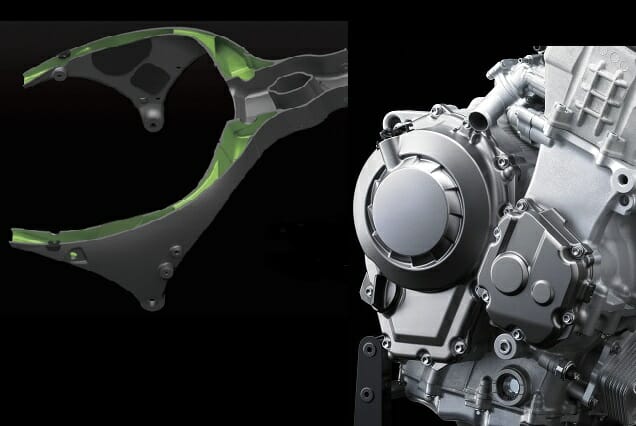
(Left) Sucking It All In: The ram air intake is a small stroke of genius. Aside from repositioning the vent closer to the 25 percent larger airbox, the sides of the top frame rails have been hollowed out so they act as resonators to quiet down the ram air system. Air enters through four holes in the front of the frame rails, swelling the inside of the frame and reducing the noise the ram air system emits.
(Right) Gearbox And Clutch: Cassette-style transmission is now quick-shifter-equipped. The gears themselves are coated in the same dry film lubricant for reduced friction as the pistons for quicker, slicker shifting. Slightly revised ratios are aimed at producing a more stable chassis on corner entry.
The clutch primary is 130.1g lighter and 4mm thinner than the 2011 bike. Back-torque limiting clutch automatically disengages when needed. Kawasaki’s race-kit parts allow you to change springs, retainers and shims when required at the track.
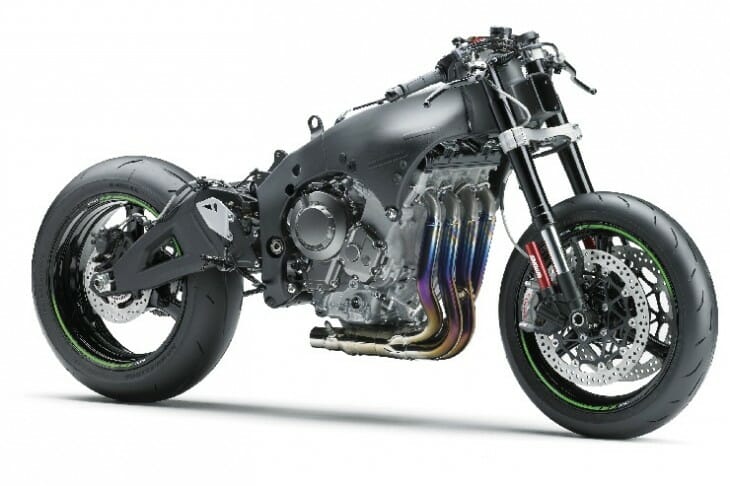
Bone Matter: Take the old frame and chuck it – that’s the motto with the new 2016 ZX-10R. Modeled closely on what Jonathan Rea, Tom Sykes and their crews found when developing their championship-winning bikes over the years, the new chassis has the engine mounted higher and more forward in the frame to get more weight over the front end. To this end also is the steering head, which is 7.5mm closer to the rider. All this is designed to increase that crucial feel the rider needs to be confident on braking, turn-in, and flicking from side to side.
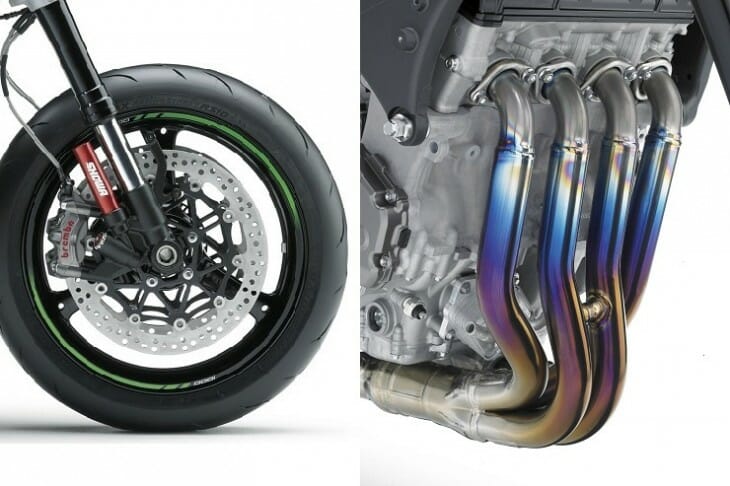
(Left) Whoa, Nelly! The front brakes house a radial Brembo master-cylinder and the same M50 four-piston monobloc calipers as found on the Ducati Panigale and KTM 1290 Super Duke R. This one however comes with race-ready braided brake lines and 330mm discs, as opposed to the 310mm units previously found. It’s the exact same system as found on the H2R. Hey, it works for that beast, why change it?
(Right) Exhaust And Muffler: Headers are once again made of heat-resistant titanium alloy, which gives off better heat distribution so the pipes themselves can be made as thin as possible. The muffler’s volume is 1.5 times more than the 2011 machine, and uses a combination of titanium alloy and stainless steel in its construction. The system uses a redesigned pre-chamber under the shock.
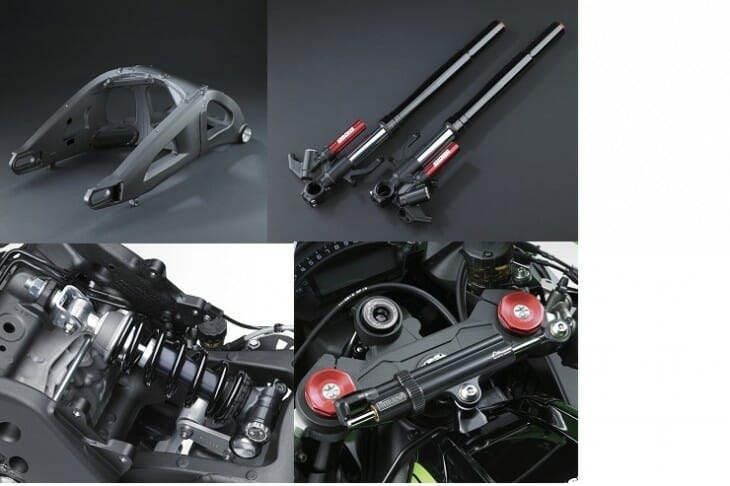 Clockwise from top left
Clockwise from top left
Swing That Arm! Kawasaki has lengthened the swingarm by a very handy 15.8mm, giving a 56.7” wheelbase, which is about half an inch longer than the old bike. Extra bracing was added, and Kawasaki worked hard to make sure the lateral (up and down) and torsional (twisting) rigidity was as close as it could get to their WSBK weapon.
Nice Legs, Baby! This is the first production bike to use Showa’s 43mm Balance Free Fork, which was developed by the Motorcard Kawasaki team in WSBK.
With the BFF, the compression and rebound damping valves are located in one place – outside the fork legs in the small red damping force chamber. This allows the entire surface of the piston to push the hydraulic fluid toward the valves in the damping force chamber, with nitrogen gas in the compression chamber pushing back against the oil, helping to maintain the balanced pressure inside the fork tube. Preload is adjusted on top of the fork.
Shocking Behavior: The rear shock is Showa’s BFRC Lite, which is a lighter, more compact version of the Showa Balance Free Rear Cushion shock originally developed for the Honda CBR1000RR. Like the fork, the damping force is generated in an external damping force chamber with independent compression and rebound-damping adjustment at the base of the shock. Preload adjustment is the old-school collar and ring system. The shock comes with high- and low-speed compression and rebound-damping adjustment.
Keep Your Head About You: Öhlins has provided the electronic steering damper, which uses inputs from the ECU to determine if the bike is accelerating or braking and changes the stiffness accordingly.
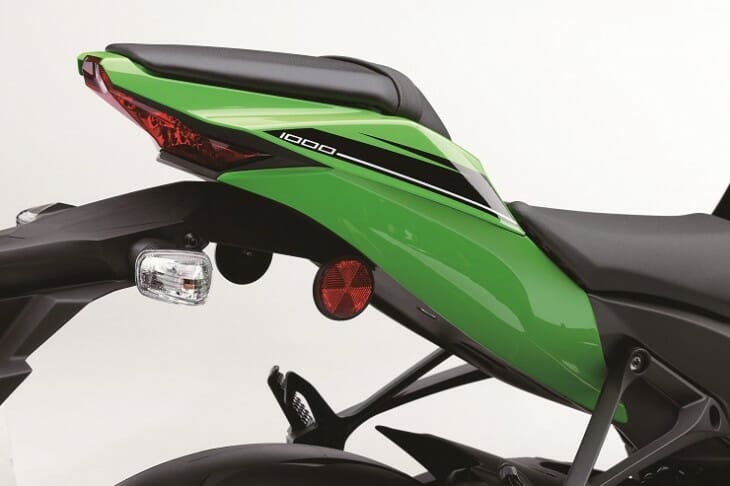
New Clothes: The bodywork on the new ZX-10R is an evolution of the radical redesign the bike went through back in 2011. The front of the machine has now been reshaped, along with the tank, side fairings and seat. The indicators have now been relocated from the inside of the seat cowling to outside as per convention. Kawasaki says this design makes for easier removal at the track. The dash is the same as the 2011 machine with a digital rev counter running horizontal across the top of the display and comes with road and track settings.
UNDERSTANDING THE INTANGIBLE
The 2016 Kawasaki ZX-10R is loaded to the brim with electronic gizmos and understanding them can be a bit of a nightmare. Even for us, there’s a lot to get our heads around, so here’s a quick breakdown of what’s up:
Sport-Kawasaki Traction Control – S-KTRC
Kawasaki’s version of traction control. Takes information gathered by the Bosch Inertial Measurement Unit across five parameters every five milliseconds to determine the amount of traction available. There are five selectable TC modes and the system is activated by cutting ignition and reducing the opening of the throttle valves. Kawasaki claims that unlike the competition which has preset limits, the S-KTRC system is a predictive system that adapts to the encountered riding conditions and available grip. For example, a power wheelie at the racetrack versus a ham-fisted wheelie on the road.
A sixth parameter is exclusive to Kawasaki’s proprietary software – yaw – which is the angular velocity around a vertical axis and works with the S-KTRC system to further enhance available traction.
Kawasaki Intelligent Braking System – KIBS
When engaged, this system allows for maximum braking pressure to be maintained before going overboard and engaging the ABS. It also means the chassis stays on line when leaned over with a handful of front brake much better than a non-KIBS vehicle. In this sense it is very similar to Bosch’s Cornering ABS system.
The system uses information from front- and rear-wheels speed sensors, hydraulic pressure from the brakes, bike position from the IMU and engine operating info to maximize available braking power and reduce the pulsing you get with normal ABS function. The first version of this appeared on the 2011 ZX-10R.
Kawasaki Engine Brake Control
This is two-stage system and allows for more or less engine braking. “L” on the dash means you get more engine braking, “Off” gives a more freewheeling character to the engine. I got my head around it by thinking “four-stroke/two-stroke.”
Engine Power Modes
The 2016 Kawasaki ZX-10R comes with three separate power modes. “Full” gives the rider 100 percent of the available power; “Mid” gives 80 percent and “Low” limits the power to 60 percent.
Kawasaki Launch Control Mode – KLCM
New for 2016, the KLCM is a three-mode system designed to maximize acceleration from a standing race start. Level one is minimal intervention, meaning the rider has to be careful on the throttle and clutch to get the jump. Level three is a high intervention where the rider just holds the throttle wide open and dumps the clutch, letting the computers take care of the rest. Level two is a mix between levels one and three. The system controls front-wheel lift and minimizes wheelspin for (hopefully) the perfect holeshot. The power mode has to be in “Full.”
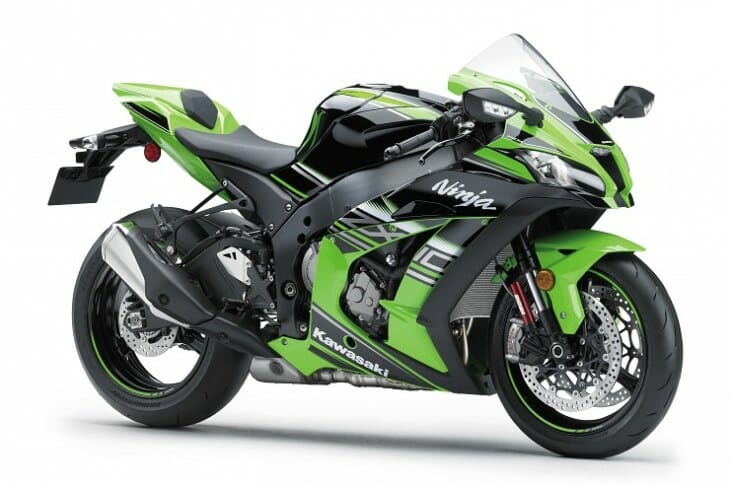
|
SPECIFICATIONS
|
2016 Kawasaki ZX-10R
|
|
Engine:
|
DOHC, four-stroke, four-cylinder, 16-valve, liquid-cooled
|
|
Displacement:
|
998cc
|
|
Bore x Stroke:
|
76 x 55mm
|
|
Compression Ratio:
|
13.0:1
|
|
Transmission:
|
Six-speed
|
|
Electronics:
|
Kawasaki Launch Control Mode (KLCM), Sport Kawasaki TRaction Control (S-KTRC), Kawasaki Engine Braking Control, Electronic Throttle Valve (ETV) Kawasaki Quick Shifter (KQS), Kawasaki Intelligent Braking (KIBS)
|
|
Chassis:
|
Twin-spar aluminum
|
|
Front Suspension:
|
43mm Showa Balance Free Fork, fully adjustable
|
|
Rear Suspension:
|
Single Showa shock absorber, fully adjustable
|
|
Front Brake:
|
Twin 330mm discs, Brembo four-piston M50 Monobloc calipers, ABS
|
|
Rear Brake:
|
Single 220mm disc, Brembo single-piston caliper, ABS
|
|
Front Tire:
|
120/70 ZR17
|
|
Rear Tire:
|
190/55 ZR17
|
|
Rake:
|
25°
|
|
Trail:
|
4.2 in.
|
|
Wheelbase:
|
56.7 in.
|
|
Seat Height:
|
32.9 in.
|
|
Overall Height:
|
45.1 in.
|
|
Overall Width:
|
29.1 in.
|
|
Overall Length:
|
82.3 in.
|
|
Fuel Capacity:
|
4.5 gal
|
|
Weight:
|
454 lbs (wet, claimed)
|
|
Colors:
|
Red/Black
|
|
MSRP:
|
$15,999/$16,299 (KRT Edition)
|
You can read the original magazine story by clicking HERE.
For more Cycle News Sport Bike motorcycle reviews, click HERE.
For more Kawasaki motorcycle reviews, click HERE.